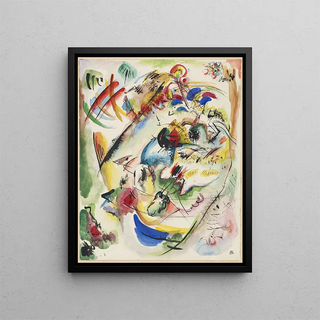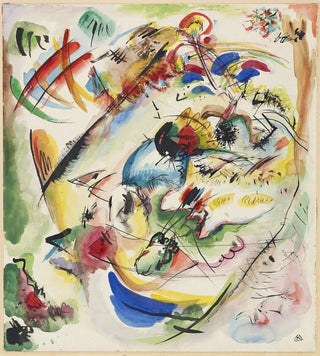Dreamy improvisation project - Wassily Kandinsky Art print


View from behind

Frame (optional)
In the fascinating universe of abstract art, the art print "Projet d'improvisation rêveuse" by Wassily Kandinsky stands out for its ability to capture the very essence of human emotion. This iconic piece, created in 1910, reflects a pivotal moment in art history, when artists began to break free from the constraints of figurative representation. Through organic shapes and vibrant colors, Kandinsky invites us to dive into a world of pure sensations, where art becomes a spiritual experience. The art print of this work allows for a rediscovery of the artist's depth of thought while offering an entry point into introspection and contemplation.
Style and uniqueness of the work
Kandinsky's style is a true visual symphony, where each color and shape intertwines to create a unique harmony. In "Projet d'improvisation rêveuse," one can observe a juxtaposition of geometric and organic forms, evoking both movement and serenity. The colors, carefully chosen, seem to vibrate on the canvas, provoking an immediate emotional reaction in the viewer. The work is not just a static representation; it becomes a dialogue between the artist and the audience, an exchange where each can interpret the elements in their own way. This innovative approach, blending abstraction and spirituality, makes Kandinsky a pioneer in the field of modern art.
The artist and his influence
Wassily Kandinsky, born in Russia in 1866, is often considered one of the founders of abstract art. His artistic vision was deeply influenced by his personal experiences, his studies in law and economics, as well as his encounters with other avant-garde artists. Kandinsky firmly believed that art should transcend the visible to touch the soul. His commitment to synesthesia, the ability to associate visual sensations with sounds and emotions, marked his work. He was also an active member of the Blaue Reiter movement, which advocated a new form of artistic expression. Kandinsky's impact on contemporary art is undeniable, inspiring

Matte finish

View from behind

Frame (optional)
In the fascinating universe of abstract art, the art print "Projet d'improvisation rêveuse" by Wassily Kandinsky stands out for its ability to capture the very essence of human emotion. This iconic piece, created in 1910, reflects a pivotal moment in art history, when artists began to break free from the constraints of figurative representation. Through organic shapes and vibrant colors, Kandinsky invites us to dive into a world of pure sensations, where art becomes a spiritual experience. The art print of this work allows for a rediscovery of the artist's depth of thought while offering an entry point into introspection and contemplation.
Style and uniqueness of the work
Kandinsky's style is a true visual symphony, where each color and shape intertwines to create a unique harmony. In "Projet d'improvisation rêveuse," one can observe a juxtaposition of geometric and organic forms, evoking both movement and serenity. The colors, carefully chosen, seem to vibrate on the canvas, provoking an immediate emotional reaction in the viewer. The work is not just a static representation; it becomes a dialogue between the artist and the audience, an exchange where each can interpret the elements in their own way. This innovative approach, blending abstraction and spirituality, makes Kandinsky a pioneer in the field of modern art.
The artist and his influence
Wassily Kandinsky, born in Russia in 1866, is often considered one of the founders of abstract art. His artistic vision was deeply influenced by his personal experiences, his studies in law and economics, as well as his encounters with other avant-garde artists. Kandinsky firmly believed that art should transcend the visible to touch the soul. His commitment to synesthesia, the ability to associate visual sensations with sounds and emotions, marked his work. He was also an active member of the Blaue Reiter movement, which advocated a new form of artistic expression. Kandinsky's impact on contemporary art is undeniable, inspiring






